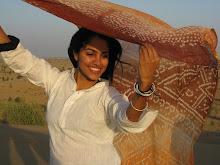


Varanasi is considered one of the must see places of India. It is located in the north in Uttar Pradesh, which is considered practically the Hindu capital. Varanasi has a river, “ganga”, which has kilometers of “ghats” (those steps leading down to the water) built along side of it. The “ganga” is considered to be very holy and people believe the waters have healing powers. Thus many of those “ghats” have themes that utilize the holy water. The city usually is bombarded with pilgrims from all over India who come to cleanse in the holy water. There are “ghats” that are focused around “poojas” a type of prayer, there are bathing “ghats” where people come every morning and bathe themselves and wash their clothes and finally there is also the cremation “ghat”.
In Hindu religion people are cremated once they have passed away. When visiting Varanasi you can literally watch from overhead, first the line of bodies waiting to be cremated, people being wrapped up in special materials, covered in wood, burned, and then their ashes being spread into the water. I know many people who have visited Varanasi and felt the actual process was disturbing. However I did not find the process disturbing but more what could be considered discrimination, in who is allowed to be cremated in this holy place, depending on your opinion of course.
Many religious people from around the country would value having their cremation done on the “ghats” in Varanasi right above the ganga. However there are certain types of people that are not allowed to be cremated. This includes from what I gathered in my bad Hindi: Sadus (wondering pilgrims devout to the religion who have renounced normal life attempting to find a higher connection to the religion), Dalits (the untouchable caste), pregnant woman, leprosy patients, poor people, people with small pox, etc. They are not allowed to be cremated; instead their bodies are tied to rocks and thrown into the river. In addition, the more you can pay the better type of wood you get. If the family has less money, the person’s cremation happens with cheaper quality wood. If the family is well off, the body will be burned with expensive wood, the highest being sandalwood. It seems very similar to how people’s coffins are chosen.
I am not trying to insult any sort or religious rituals, I just find it interesting and became more aware in Varanasi that your social and financial status can even follow you to your death, as in many other religions.
Katie and I also noticed that even though the family members were there at the cremation, there was very little, obvious grieving. I am sure there was internal grieving that we wouldn’t be able to recognize, however we are more accustomed to people mourning openly, obviously. At the cremation “ghats” where there were plenty of families holding the last rights for their deceased family members, yet there was not this overpowering sense of sadness, but more of a, people are doing their work and getting on their way feeling. It makes you speculate, in a country when there is so much death because of poverty, general diseases and because the population is so large, does death become less painful, more accepted? Or is it that people just grieve in a different way, more of a cultural sort form of expression?
The second picture is men carrying wood for the cremation. You can see in the back all the piles of wood.
For all the pictures of Varanasi:
http://www.facebook.com/album.php?aid=2228967&l=2a2b5&id=6011342

1 comment:
Very interesting observations about how Indians handle death, Nafessa.
My observations about the Indian/Sub-Continent culture and people that come from it are that adversity is not looked upon as such a debilitating thing as it is in the west. When you have something tough happen or when you are presented with a situation that is not optimal, Indian's tend to quickly look beyond the problem and serach for a solution or work their way to a solution.
Look at our family history. In the last 2 generations (going back to Abjan) we have had to re-build our lives/fortunes/jobs/homes at least 3 or 4 times. Your Mom might be too young to remember these, but I'm sure she knows the stories. I've heard stories of a time when Abjan was young and had to start from scratch because the trustees of his father's estate would not give him any of the money intended to take care of him. And of times a few years later when all the siblings were split up to live at various family friends houses, because times were hard or the time when a fire burnt down the family home. Then when the nationalization campaigns started in East Africa during the 60's (after independence) Abjan had to move to Pakistan and abandon everything they had built up in East Africa. And then the move to the West that happened with each of the siblings at different times and the re-starting they had to do. Through all of these adversities or non-optimal situations, our Indian culture dictated that we didn't wallow in misery or grief but rather looked for any way to find a solution and some way to re-build.
I suspect that in Varanasi you were observing a bit of this aspect of Indian culture.
Post a Comment